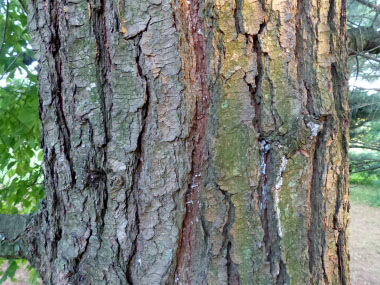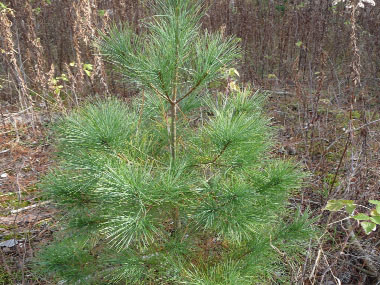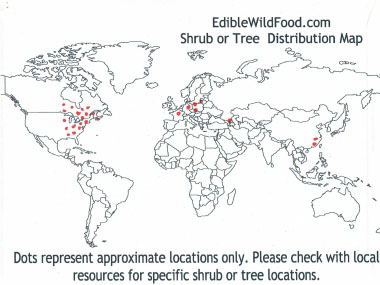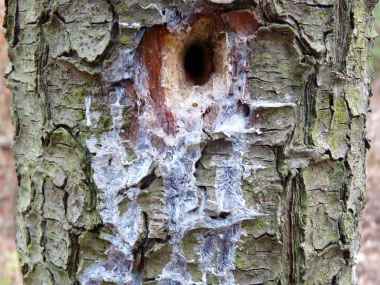










For more in-depth information (e.g. nutrition, medicinal values, recipes, historical information, harvesting tips, etc.) please check out our White Pine PDF magazine.
Also known as the Northern White Pine, this pine tree is a fast growing, sturdy, and majestic tree that can live up to 200 years. It is in the Pinus (pine) family which has about 100 species worldwide. Pines are divided into three subgenera relative to the number of needles emanating from a common basal sheath; two-needled, three-needled, and five-needled pines. Historically this tree is known for many uses including ship masts; today, it is used in construction and in carpentry. The bark has a strong resistance to fire.
Trunk/Bark
Trunks are tall, straight and can reach diametres of up to one metre (3'). Young bark is thin, greyish-green, and smooth. Mature (outer) bark is 2 to 5 cm (1 to 2”) thick with broad ridges of dark-tinged scales.
Branches/Twigs
Branches are stout, irregular in shape, and grow horizontal to ascending. Twigs are flexible, green and in the first year, hairy.
Height
The eastern white pine can grow to be more than 40 metres tall.
Leaves/Needles
Being a conifer, the pine has needles, not leaves. The needles are light, bluish-green, soft, straight and slender. Needles measure anywhere from 5 to 15 cm (2 to 6”) long, are three-sided, finely toothed, and occur in bundles of 5. They will drop anywhere from one to four years depending on conditions.
Flowers
Not applicable.
Fruit
Male and female cones grow on the same tree. Male cones are yellow, small, and clustered at the base of the current year's growth. Female cones are what stands out. The eastern white pine female cones measure 8 to 20 cm (3 to 8”) long and they hang downward from the branches. Typically a tree is 20 or 30 years old before it reproduces, and then only every 3 to 5 years. The female cone matures in two to three years and drop soon after shedding the seeds.
Habitat
White pine trees can be found anywhere from dry rocky ridges to sphagnum bogs. It tends to prefer cool, humid areas with well-drained soils. This tree is found anywhere from the central to eastern parts of Canada and the U.S., as well as in parts of Europe. In Europe, this tree is better known as the Weymouth.
Edible Parts
Pine needles can be dried and ground into smaller parts for tea. They can be ground down to use in baking or cooking. Although the inner and outer park can be used as a food source this is only in a survival situation. Pine sap can be used as a source of nutrients as well. Pine needles contain a wealth of nutrients.
Other Name
White Pine.
Recipes
Balsamic Vinegar, Chewy Pine Granola Bars, Coconut Pine Cookies, Conifer Muffins, Easy-to-Make Pine Cookies, Ginger Cookies, No Bake Pine Treats, Peanut Butter Pine Bars, Peanut Butter Cookies, Peanut Butter Cups, Pine Apple Crisp, Pine Cake, Pine Cookie Ornaments, Pine Cookies, Pine Current Cookies, Pine Muffins, Rum Balls, Homemade Salt Scrub, Pine Tea
To support our efforts please browse our store (books with medicinal info, etc.).
Winter Survival Food Handbook

PDF Plant Magazines
Types of Wild Food
Geographic Zones Seasons
Disclaimer
EdibleWildFood.com is informational in nature. While we strive to be 100% accurate, it is solely up to the reader to ensure proper plant identification. Some wild plants are poisonous or can have serious adverse health effects.
We are not health professionals, medical doctors, nor are we nutritionists. It is up to the reader to verify nutritional information and health benefits with qualified professionals for all edible plants listed in this web site. Please click here for more information.
Why Edible Wild Food?
- Food costs are rising
- Free, wild food is readily abundant
- Wild food adds nutrition to your diet
- Wild food can help treat various medical conditions





